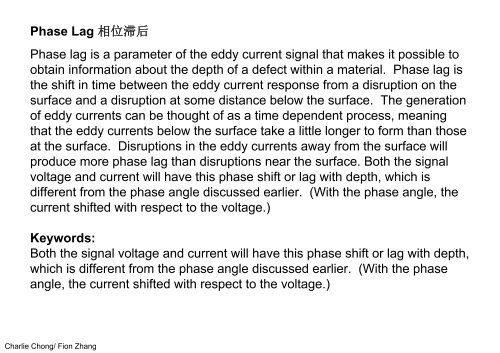Electromagnetic Testing - Eddy Current Testing Procedures
Eddy current chapter 4 procedures
Eddy current chapter 4 procedures
You also want an ePaper? Increase the reach of your titles
YUMPU automatically turns print PDFs into web optimized ePapers that Google loves.
Phase Lag 相 位 滞 后<br />
Phase lag is a parameter of the eddy current signal that makes it possible to<br />
obtain information about the depth of a defect within a material. Phase lag is<br />
the shift in time between the eddy current response from a disruption on the<br />
surface and a disruption at some distance below the surface. The generation<br />
of eddy currents can be thought of as a time dependent process, meaning<br />
that the eddy currents below the surface take a little longer to form than those<br />
at the surface. Disruptions in the eddy currents away from the surface will<br />
produce more phase lag than disruptions near the surface. Both the signal<br />
voltage and current will have this phase shift or lag with depth, which is<br />
different from the phase angle discussed earlier. (With the phase angle, the<br />
current shifted with respect to the voltage.)<br />
Keywords:<br />
Both the signal voltage and current will have this phase shift or lag with depth,<br />
which is different from the phase angle discussed earlier. (With the phase<br />
angle, the current shifted with respect to the voltage.)<br />
Charlie Chong/ Fion Zhang


















